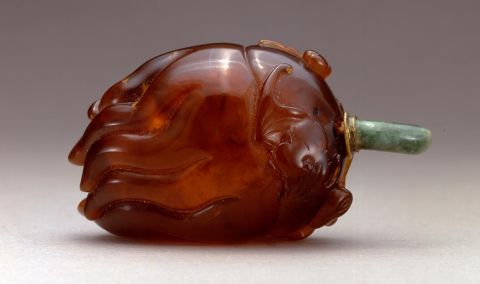
Bottle ID: 67
FINGER CITRON
Date: 1750-1800
Height: 57 mm
Amber, very well hollowed, of rich dark brown tone, carved in the form of a Buddha's hand or finger citron, its exterior carved in relief with a bat flying around fruiting tendrils.
Possibly imperial, attributed to the Palace Workshops.
Similar Examples:
Chang Lin-sheng. Snuff Bottles in the Collection of the National Palace Museum, Taipei, Taiwan, 1991, p. 259, no. 389.
Hughes, Michael C. The Blair Bequest - Chinese Snuff Bottles from the Princeton University Art Museum, 2002, p. 92, no. 92.
Moss, Hugh, Victor Graham and Ka Bo Tsang. A Treasury of Chinese Snuff Bottles - The Mary and George Bloch Collection, Vol.7, Part 2, pp. 438-439, no. 1650.
Provenance:
Clare Lawrence Ltd.
Richard A. Bourne Co. Inc., MA, December 14, 1988, lot 32
Marion Mayer
Published:
Stevens, Bob C. The Collector's Book of Snuff Bottles, 1976, p. 176, no. 683
The Buddha’s Hand or Finger Citron takes its name from the shape of its fruit, which is said to resemble the outstretched hand of the seated Buddha. This citrus fruit is inedible in its raw state, but exudes a strong fragrance which, together with its form, makes it a pleasing decorative addition to the home. The Empress Dowager, Cixi (1835-1909) used large containers of Finger Citrons within her palace in the Forbidden City to make her residence more fragrant and pleasing. The Finger Citron is known as Foshou, which provides for a pun with fu and shou meaning blessings and longevity whilst the presence of the bat adds more blessings. Since amber was symbolic of longevity also, the Crane bottle is overflowing with blessings for a long life.
< Back to full list
 English
English 中文
中文